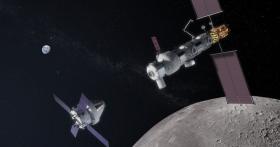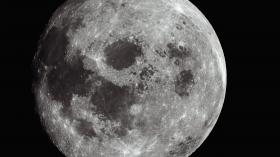- Showing:
- All Topics
Science | Science & Technology
Science & Technology | Science
Twists in Spacetime Might Explain Some of The Brightest Objects in The Universe
A 3D model of a black hole's erratic feeding pattern reveals a potential explanation for the bizarre behavior of quasars with a dimmer switch.
Science & Technology | Science
SpaceX's interplanetary rocket fires up engines in unprecedented test | CNN Business
SpaceX attempted to ignite all 33 engines in a test fire of its gargantuan Super Heavy rocket booster. The trial marks the company's first static fire test for what is expected to be the most powerful launch vehicle ever built.
Science & Technology | Science
See the green comet near Mars in the night sky this week
Comet C/2022 E3 (ZTF) will be close to Mars in the Taurus constellation from Feb. 9 through Feb. 14, making it easier to locate as it dims in the night sky.
Science & Technology | Science
Rare 'green pea' galaxy may be the most 'chemically primitive' galaxy ever discovered
A 'green pea' galaxy seen in an early James Webb Space Telescope image may be the most chemically primitive galaxy ever discovered.
Science & Technology | Science
Physicists Have Achieved The Smallest Measurement Yet of a Ghost Particle's Mass
Earlier this year, decaying isotopes of hydrogen gave us the smallest measurement yet of the mass of a neutrino.
Science & Technology | Science
Breakthrough rocket engine could travel at 99% the speed of light
When it comes to space, there's a problem with our human drive to go all the places and see all things. A big problem. It's, well, space.
Science & Technology | Science
One of the most extreme black hole collisions in the universe just proved Einstein right
The black hole twisted 10 billion times faster than any ever observed.
Science & Technology | Science
Why do galaxies spin?
The Universe begins with negligible amounts of angular momentum, which is always conserved. So why do planets, stars, and galaxies all spin?
Science & Technology | Science
The Curiosity rover has been exploring Mars for 10 years. Here's what we've learned.
Curiosity landed on Mars on Aug. 5, 2012, with one main goal: to determine whether the planet was once habitable. In 10 years, it has answered that question and many others, even as it has inspired ne
Science & Technology | Science
Two skyscraper-size asteroids are barreling toward Earth this weekend
Two asteroids, 2016 CZ31 and 2013 CU83, are headed toward Earth for back-to-back flybys this weekend.
Science & Technology | Science
NASA to launch 2 more choppers to Mars to help return rocks
NASA is launching two more mini helicopters to Mars in its effort to return Martian rocks and soil samples to Earth. Under the plan announced Wednesday, NASA’s Perseverance rover will do double duty and transport the cache to the rocket that will launch
Science & Technology | Science
NASA's Orion: Everything We Know About The Spacecraft That Will Carry Astronauts To The Moon
A rocket is just the thing that provides lift into orbit. You need a spacecraft to carry humans on a mission, and NASA has one called Orion up its sleeve.
Science & Technology | Science
Humans are evolving a new artery
More humans are being born with a third arm artery, an example of microevolution happening right before our eyes.
Science & Technology | Science
Jaw-dropping image combines 32 years of Hubble telescope photos into one
After celebrating 32 years of Hubble observations, a physicist has combined all of the snapshots of Hubble's exploration into one image.
Science & Technology | Science
SpaceX's Crew-4 astronaut mission for NASA cleared for April 23 launch
NASA and SpaceX teams found no big issues during Crew-4's flight readiness review.
Science & Technology | Science
NASA finally opened 50-year-old Apollo moon rock sample as agency eyes human return to lunar surface
'It's just the best thing in the world — like a kid in the candy store.'
Science & Technology | Science
For the First Time Ever, Scientists Witnessed—and Recorded—Orcas Stalking and Killing a Blue Whale
New video evidence shows that orcas are capable of hunting and killing blue whales—the largest animals on Earth.
Science & Technology | Science
Warp drives: Physicists give chances of faster-than-light space travel a boost
If humanity ever wants to travel easily between stars, people will need to go faster than light.
Science & Technology | Science
NASA’s Ingenuity Helicopter Has Landed on the Surface of Mars
NASA’s Ingenuity helicopter is one step closer to taking its first flight on Mars. On Saturday, the space agency announced that the helicopter had been successfully dropped off on the surface of the planet by the Perseverance rover, which has essentially
Science & Technology | Science
NASA is figuring out how to feed astronauts heading to Mars
How do you feed humans on six month space trip?
Science & Technology | Science
Scientists find possible sign of life on Venus
Astronomers have found phosphine in the atmosphere of Venus, possibly indicating life.
Science & Technology | Science
NASA and SpaceX say they are ‘go’ to proceed with historic crewed flight on May 27th
After two days of review, NASA and SpaceX have mutually decided to proceed with the company’s historic flight on May 27th of launching two astronauts to the International Space Station from Florida. However, there is still a lot of work to complete over t
Science & Technology | Science
Space Photos of the Week: Happy Birthday, Hubble! | WIRED
Every year on the telescope's birthday, we're the ones who get a gift: a brilliant and never-before-seen snapshot of the cosmos.
Science & Technology | Science
SpaceX’s Starship rocket prototype collapsed on itself this weekend
Videos show SN1 crumpling during a pressure test.
Science & Technology | Science
Interstellar space even weirder than expected, NASA's Voyager 2 reveals
The spacecraft is just the second ever to venture beyond the boundary that separates us from the rest of the galaxy.
Science & Technology | Science
Japan will help NASA build a space station near the Moon
Japan will join NASA's Artemis lunar exploration program.
Science & Technology | Science
Jupiter just got slammed by something so big we saw it from Earth
It's bright, it's white and fortunately it's very far away from here.
Science & Technology | Science
What Is a Light-Year? | Space
On the scale of the universe, measuring distances in miles or kilometers just doesn't cut it. That's why you may often hear astronomers use the term light-year. But what exactly is a light-year?
Science & Technology | Science
Earth's magnetic north pole is moving too fast for experts to keep up. Now scientists might know why.
Scientists have modeled the jerks inside our planet's core that cause magnetic north to go haywire. Accurate models of magnetic north inform our GPS.
Science & Technology | Science
The solar system's hidden Planet X may finally be spotted soon
A new paper suggests the hidden world known as Planet X is closer to being seen than previously thought.
Science & Technology | Science
What if the most powerful nuclear bomb exploded in space
During the Cold War, the US government launched a 1.4 megaton bomb into space. Starfish Prime, as the test was called, was the highest-altitude nuclear test in history. But what would happen if we tried the same experiment with a 50 megaton bomb, like the
Science & Technology | Science
You know that smell after it rains? Here's where it comes from
A new study may finally identify the mechanism through which the earthy smell of rain gets into the air, and it has to do with "frenzied aerosols."
Science & Technology | Science
Medical dilemma of 'three-parent babies': Fertility clinic investigates health of 17 teenagers it helped to be conceived through controversial IVF technique
A private fertility clinic in the United States has launched an investigation into the health of 17 teenagers who were born as a result of a controversial IVF technique that produced the world’s first “three-parent” embryos more than 15 years ago, T
Science & Technology | Science
Absolutely mindblowing video shot from the Space Shuttle during launch
Drop whatever you're doing and watch this. NASA has released videos shot from onboard the Space Shuttle's Solid Rocket Boosters in the past, but you've never seen one prepared as masterfully as this.
Science & Technology | Science
Microbial life found living on the exterior of the International Space Station?
A new report claims that Russian scientists have discovered traces of marine life living on the exterior of the International Space Station (ISS).
Science & Technology | Science
Astronomers discover Earth-sized 'diamond' 900 light years away
The world's largest diamond, the Cullinan, is a tad over 3,100 carats uncut. Its estimated value is some $2 billion, and it only weighs about 1.37
Science & Technology | Science
Scientists achieve reliable quantum teleportation for first time
Einstein is wrong? That's the potential outcome of a quantum mechanics study as scientists race to disprove his views on entanglement.
Science & Technology | Science
These Are Some of the Oldest Living Things on Earth | Science | WIRED
Animals sometimes sleep inside the hollows of giant 2,000-year old baobab trees inside Kruger Game Preserve in South Africa. Humans too, sometimes use the trees, for more dubious purposes -- a jail, a toilet, a pop-up bar -- as photographer Rachel Sussman
Science & Technology | Science
Is there life on Saturn’s moon Enceladus? Looks like there’s plenty of liquid water, for starters.
Liquid water mixing with rock on this distant moon could create chemistry necessary for life, scientists report.
Science & Technology | Science
The South Pole Is a Great Place to View Space
The Big Bang radiation discovery happened there-and when you look at Antarctic conditions, you can understand why.
Science & Technology | Science
Meteorite hits moon in largest lunar impact ever recorded - video
Astronomers capture the moment a Meteorite hits the moon on 11 September 2013
Science & Technology | Science
Giant Laser Complex Makes Fusion Advance, Finally
Two experiments in which hydrogen fusion generated more energy than had been put in to the hydrogen succeeded, an advance that revives optimism in thermonuclear fusion.
Science & Technology | Science
Mars Radiation Risk 'Manageable' for Human Missions : DNews
The risk of radiation exposure is not a show-stopper for a long-term manned mission to Mars, new results from NASA's Curiosity rover suggest.
Science & Technology | Science
Brilliant Maps Reveal Age of the World's Buildings - Wired Science
When Justin Palmer stumbled across a dataset that included the year nearly every building in the Portland metro area was built, he was curious how old the buildings on his block are. Instead of just searching the data for his neighbors’ addresses, he made the beautiful map above.
Science & Technology | Science
3D Printing Aims to Deliver Organs on Demand
Dying patients could someday receive a 3D-printed organ made from their own cells rather than wait on long lists for the short supply of organ transplants. Such a dream remains far from reality, but labs have already taken the first steps.
Science & Technology | Science
8 Brilliant Scientific Screw-ups
They say that patience is a virtue, but the following eight inventions prove that laziness, slovenliness, clumsiness and pure stupidity can be virtues, too.
Science & Technology | Science
Great mirages of the world
Though mirages are just optical illusions, they are very real manifestations of physics and remind us that the universe is not as linear and straightforward as we’d like to think. While the classic arid-land mirage – a “lake” shimmering in the dis
Science & Technology | Science
Maven: Building a time machine for Mars
Our space correspondent goes behind the scenes at Nasa’s forthcoming quest to reveal how and why the red planet lost the majority of its atmosphere.
Science & Technology | Science
Curiosity snaps
For the one-ton Mars rover Curiosity, self portraits are becoming an essential staple of its time on the Martian surface. And the latest is a doozy.




























































